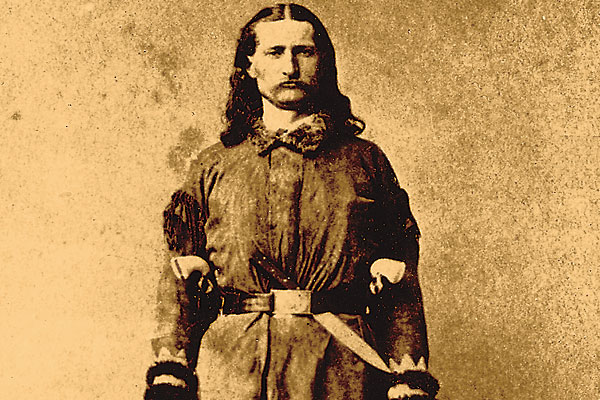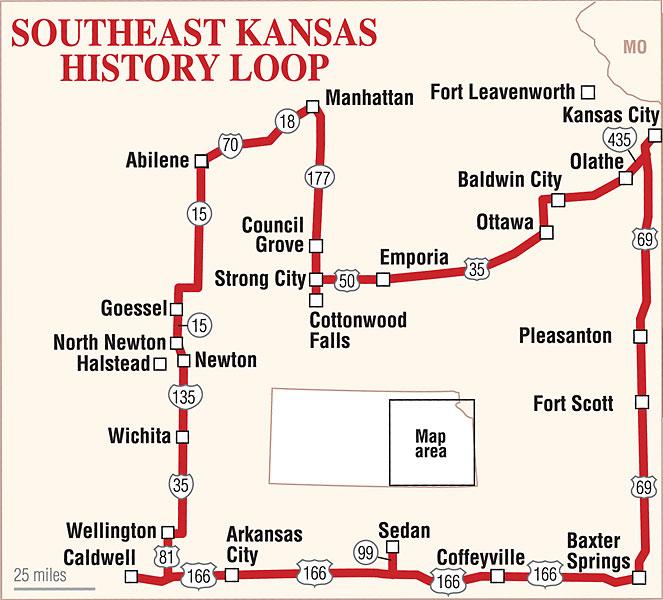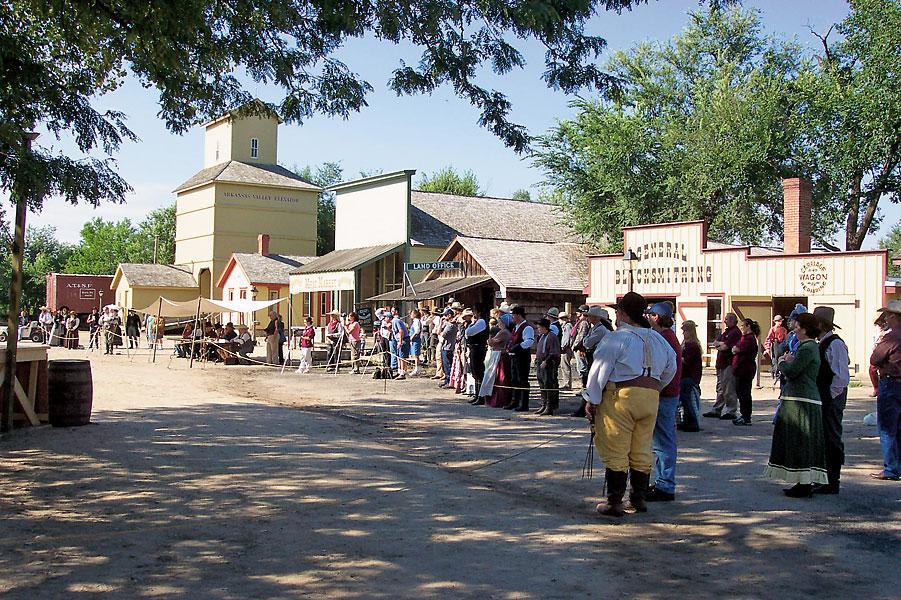 You’re Riding Shotgun With…
You’re Riding Shotgun With…
 Orin Friesen, whose passions are the Chisholm Trail, Texas Longhorn cattle, the Pony Express and Kansas history. A serious student of history for more than 50 years, Friesen is the operations manager of the Prairie Rose Chuckwagon Supper, plays bass for the Prairie Rose Rangers and is curator of the Silver Screen Cowboy Museum.
Orin Friesen, whose passions are the Chisholm Trail, Texas Longhorn cattle, the Pony Express and Kansas history. A serious student of history for more than 50 years, Friesen is the operations manager of the Prairie Rose Chuckwagon Supper, plays bass for the Prairie Rose Rangers and is curator of the Silver Screen Cowboy Museum.
He doesn’t just talk the talk when it comes to preserving Kansas’s Old West heritage; he walks the walk. In 2011, he spearheaded a drive to raise money for the restoration of the Kansas cabin where, in 1871, Dr. Brewster Higley wrote “Home on the Range,” the state song.
In his spare time, Friesen raises horses on his Rocking Banjo Ranch and shares the stories behind Kansas’s historic sites. Last year he helped celebrate the state’s 150th anniversary by helping folks explore the Pony Express Trail. On this loop, he shares a bit of all his favorite history subjects, along with some road trip tunes that come to mind whenever he visits these sites.
COFFEYVILLE, KS
“Go down Bill Dalton, it must be God’s will. Two brothers lyin’ dead in Coffeyville, two voices call to you from where they stood,” the Eagles sang in 1973.
Coffeyville is a gold mine for those who love Old West outlaw history. It’s where, in 1892, the Dalton Gang met its fate while trying to rob two banks at once.
The Perkins Building, which housed one of those banks, still stands; now it’s the spot to go to find out the great historic sites in the area, as it is the home of the Coffeyville Area Chamber of Commerce, Convention & Visitors Bureau and of Downtown Coffeyville.
That’s just the start of the Dalton tour. You can also visit Dalton Defenders Plaza & Death Alley, and the Elmwood Cemetery with the graves of three Dalton brothers (two of whom were killed on that fateful day). The Dalton Defenders Museum helps you travel back in time to that day, with its artifacts tied directly to the Dalton Gang, including revolvers carried by Bill Power, Bob Dalton and Emmett Dalton, the sole gang member to survive the gunfight that day.
ARKANSAS CITY, KS
“Someday I’ll make a trip, back to that Cherokee Strip” goes the Bob Wills classic that Merle Haggard turned into a hit.
As you go through Arkansas City (pronounced Ar-Kansas, just like the river of the same name is pronounced in Kansas), make sure to visit the Cherokee Strip Land Rush Museum. Besides commemorating the great land rush of 1893, the museum also has a replica of a Wichita Indian village that was originally located nearby.
CALDWELL, KS
Even though he’s singing about riding around the red rocks of Texas, whenever I hear Brenn Hill sing the lines, “I could feel the gunfight, Knew it was comin’ soon,” I figure that train of thought surely must have passed through the minds of many of the law and order men who tried to keep a handle on Wild West hooligans.
When Mike Meagher hung up his hat as a marshal in Wichita and became the mayor of Caldwell, he probably thought he had left that worry behind him. Yet when Jim Talbot and his gang came shooting into town on December 17, 1881, Meagher ended up dead.
As you stroll downtown, you can read more about this Talbot Gang shoot-out, as well as other historical events and people. Stop at the Cherokee Strip Center for a free tour guide of the downtown historical markers.
WELLINGTON, KS
Chuck Miller was born in Wellington in 1924, and one of the songs he sang with his Chuck Miller Trio was a Western Swing hit called “Cow Cow Boogie.” When you drive through his hometown, be sure to put on that tune, so you too can sing “Cow cow boogie in the strangest way. Comma ti yi yi yeah. Comma ti yippity yi yeah.”
In Wellington, you’ll want to check out the Chisholm Trail Museum and its displays and artifacts of the Chisholm Trail that ran just seven miles west of town. The cattle herds coming up the trail played an important role in the early economy of this town, which was first surveyed in 1871.
WICHITA, KS
Tex Ritter sang a song called “Wichita,” with a chorus that went: “Back in Wichita, law and order prevail. Take me back to Wichita, let me ride that Wichita trail.” When I visit this town, the song’s ending refrain still rings true: “Today, it’s a very nice town. A very nice town.”
Wichita was one of the important cattle towns on the Chisholm Trail. Located along the Arkansas River near the center of Wichita, Old Cowtown Museum depicts Wichita as it was in the 1870s during its heyday as a cattle town. With more than 45 historic and replica buildings, Cowtown is one of the finest representations of an Old West town anywhere. It is a “must see” attraction for anyone interested in the history of the American West.
While you’re in Wichita, save time for the all-you-can-eat Prairie Rose Chuckwagon Supper followed by a show performed by me and the Prairie Rose Rangers. You can also take a horse-drawn wagon ride, watch a cowboy movie or visit the Silver Screen Cowboy Museum. The Prairie Rose Ranch is only 15 minutes from Wichita.
HALSTEAD, KS
If you “fall to pieces” every time you hear Patsy Cline’s “Crazy,” you may have lots to talk about with the gal who owns Kaleo Café. Owner Kim Coslett, the lead singer for the Prairie Rose Rangers, sometimes performs tribute concerts to the famous Country singer. Even if you’re not a Patsy fan, stop by the café and snack on a slice of Kim’s homemade carrot cake or peanut butter pie.
A block north on Main Street, visit the Old Hardware Store. It’s like stepping back in time. The hardware store has been in business since 1885 and still sells many of the items it sold when it first opened. Proprietor Margaret Kraisinger will greet you and show you around. She’s quite the historian herself, and she and her husband, Gary, wrote the definitive book on the history of the Great Western Cattle Trail.
NEWTON, KS
“Gold was just a windy Kansas wheatfield, and blue was just a Kansas summer sky,” John Denver sang in his 1974 song about a Kansas farmboy.
Mennonite farmers made this area famous with their fields of Russian Red Winter Wheat, introduced to Kansas in 1873. You can learn more about them, Newton’s Chisholm Trail history, prairie homesteaders and the area’s American Indians at the Kauffman Museum, a part of Bethel College in north Newton.
GOESSEL, KS
“Oh, the high hawk knows where the rabbit goes, and the buzzard marks the kill. But few there be with eyes to see the tall men riding still. We hark in vain on the speeding train, for an echo of hoofbeat thunder. And the yellow wheat is a winding sheet, for cattle trails plowed under,” was penned by cowboy poet S. Omar Barker and has been set to tune by numerous folk singers.
To find out more about that winding sheet of yellow wheat, a treat awaits you in Goessel, as you head up the Chisholm Trail to Abilene. The Mennonite Heritage & Agricultural Museum not only shares the history of wheat farming in Kansas, but also offers up eight 100-year-old buildings you can visit.
ABILENE, KS
“Then in ’69 he headed back to Kansas with his horse and pack, to become the U.S. marshal at Abilene. With his fearless heart and his trusty gun, he kept the outlaws on the run, and his justice was the fairest ever seen,” sang the Peter Pan Orchestra, on a Songs of the West album you might have heard when you were a young cowpoke.
When you visit Old Abilene Town, you’ll feel like you’ve gone back to the days when Wild Bill Hickok was marshal.
As the original trail head of the Chisholm Trail, Abilene was the first town to be established as a cattle town. After your trip to Old Abilene town, you should also take in President Dwight D. Eisenhower’s boyhood home as well as the Presidential Library and Museum. In 1878-79, the Eisenhauer clan moved from Pennsylvania to the Abilene cowtown, and the boy who would grow up to be our 34th president is buried here, in a chapel on the grounds of the library.
If you plan your trip accordingly, in May through October, you might be able to catch a ride on the historic Santa Fe steam train now operated by the Abilene & Smoky Valley Railroad.
COUNCIL GROVE, KS
In 1911, James Grafton Rogers penned “The Santa Fe Trail” song: “I seen her ride down the arroyos, way back in the Arkansas sand, with a smile like an acre of sunflowers, and her little brown quirt in her hand. She straddled the pinto so airy, and rode like she carried the mail. And her eyes near set fire to the prairie, ’longside of the Santa Fe Trail.”
Council Grove was an important stop on the Santa Fe Trail. Visit the Kaw Mission, which dates back to 1851. Daniel Boone’s grandson, Seth Hays, opened the Hays House Restaurant & Tavern in 1857. It’s the oldest, continuously-operating restaurant west of the Mississippi. Have dinner in the same place where legends like George Armstrong Custer once dined.
STRONG CITY, KS
“All in all, they had it good. Life as solid as ironwood, in the flint hills of Kansas,” the soulful Country Rock singers Nathan Bell & Susan Shore sang in 1989.
In the heart of the Kansas Flint Hills, not far from Council Grove, is the 1880s Spring Hill Farm & Stock Ranch, now known as the Tallgrass Prairie National Preserve. There, you can visit the historic limestone ranch buildings, take a tour of the prairie and view a herd of buffalo.
COTTONWOOD FALLS, KS
“Our prairie evening party has a guest list miles long, of critters who all come to life when evening’s comin’ on. Our hostess is the hoot owl, perched high up on a limb. She’s calling out to all her friends, ‘Who-who’s comin’?’” is from a song some Cottonwood Falls folks will know well.
Just down the road from Strong City is Cottonwood Falls, a town dating back to the 1850s. The French Renaissance courthouse, built in 1873, is in itself worth the trip.
While you’re in town, grab some grub at the Emma Chase Café. If you time your meal right, you might even catch a live performance by some of the local cowboy musicians, like the Tallgrass Express, who sings the noted song on the band’s album, Clean Curve of Hill Against Sky: Songs of the Kansas Flint Hills.
EMPORIA, KS
“I was out walking an’ a-ramblin’ one day. I spied a fair couple a-comin’ my way. One was a lady as fair as could be, an’ the other a cowboy, an’ a brave one were he. An’ the other a cowboy, an’ a brave one were he,” comes from a folk song sung by Cowboy Celtic on the band’s 2001 album, Drover Road.
One of the greatest contributions Welsh settlers gave Emporia was their love of music. Among the first concerts they held here was in December 1875, around the time when the traditional Welsh music festival, Eisteddfod, was held. Today, the town still pays tribute to its Welsh heritage with a musical celebration in March to honor the Welsh patron saint, St. David, while December usually means music and songs at the W.L. White Auditorium and downtown horse carriage rides.
Some of the town’s best historic sites are linked to W.L. White’s father, the editor of the Emporia newspaper he purchased in 1895: his 1899 home, and the museum of the newspaper, which is still operated by the fourth generation of the White family.
Within Striking Distance: Kansas Frontier Military Side Tour
FORT LEAVENWORTH, KS
The Frontier Army Museum exhibits one of the finest collections of horse-drawn military transports in the nation (including a 1790 prairie schooner!). With its focus on the fort’s role in westward expansion, this is a great first stop on your Kansas frontier military tour.
OLATHE, KS
Confederate guerrilla William Quantrill and his men raided Olathe just after midnight, on September 7, 1862. One of the raiders apparently dropped a flag in the town square. Resident Jonathan Millikan found it, and his son, Orin, donated it to the state historical society in 1930. (The seven-by-13-inch flag is now housed at the Kansas Museum of History in Topeka.) Quantrill’s bushwhackers did not scare off the Mahaffie family; you can still see three of the family’s original buildings at the Mahaffie Stagecoach Stop and Farm Historic Site.
KANSAS CITY, MO/KS
In 1864, Confederate Gen. Sterling Price and his men met defeat in Westport, now part of Kansas City on the Missouri side. (Kansas City on the Kansas side would be formed after the Civil War, in 1868.) The Westport battle tour route starts at the Harris-Kearney House, across the street from Kelly’s Westport Inn (the city’s oldest building), where Maj. Gen. Sam Curtis had his headquarters. Learn more about the battle at the Trailside Center.
When you cross the border back into Kansas, be sure to stop at the Grinter Place, an 1857 home that housed Annie and Moses Grinter. Forts Leavenworth and Scott troops sometimes crossed the Kansas River on a ferry operated by Moses.
PLEASANTON, KS
The second-largest cavalry battle in the Civil War took place near present-day Pleasanton at Mine Creek, on October 25, 1864 (“approximately 2,800 Union cavalrymen overwhelmed 8,000 Confederates,” states the historic marker). Visit the Mine Creek Battlefield and walk where Maj. Gen. Alfred Pleasonton led his men to defeat the larger Confederate force in under an hour.
FORT SCOTT, KS
Built in 1842, Fort Scott saw troops fighting Indians and in the Mexican-American War. It closed in 1853, just a year before violent political confrontations known as “Bleeding Kansas” broke out between Kansas and Missouri over whether or not Kansas would enter the Union as a free or slave state. The Army opened the fort again in 1862, to train Union troops for the Civil War. The national historic site shares all these stories, as well as offers a living history program about 1840s life. The Fort Scott National Cemetery is the resting place of troops ranging from the 1st Kansas Colored Volunteers, to Buffalo Soldiers to American Indian soldiers who served during the Civil War.
BAXTER SPRINGS, KS
In 1862, field camps were built in Baxter to supply troops escorting wagon trains through Indian Territory. Fort Blair was built in July 1863. Only a few months later, in October, Indians weren’t the ones who struck, but rather Confederate guerrillas under William Clarke Quantrill. In that Battle of Baxter Springs, 132 soldiers perished. The dead are buried in Baxter Springs Cemetery, west of the city. You’ll find the Fort Blair site on Route 66 on 6th Street. You should also take a walk in downtown down Military Avenue, and check out the framed accounts of people and events tied to the historic buildings.
{jathumbnail off images=”images/stories/Apr-2012/small/orin_friesen.jpg”}
Photo Gallery
Bob Dalton (above) was killed, along with his brother Grat, Bill Power and Dick Broadwell, after robbing the Condon National Bank and First National Bank in Coffeyville. Only Emmett Dalton lived, having survived 23 gunshot wounds.











